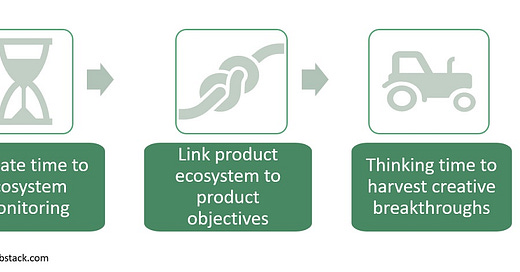Understanding Your Product's Environment
How to thrive as a product manager by staying aware of your product ecosystem
The layoff came out of the blue and hit a favorite co-worker on your product management team. John, your laid-off co-worker, was the product manager for your traditional software product that is used by your biggest enterprise customers. In contrast, you are working on a re-architected version of the product that runs in the Public Cloud. Your product is used by a few small customers and you've missed sales forecasts several times.
How could this happen and why does this happen to accomplished product managers like John? How do you protect yourself from being like John? One way to stay ahead of product impacts is to know your product's business ecosystem.
Why Does a Product Ecosystem Matter?
The key reasons to know your product's ecosystem are:
To understand what your competitors are doing
To better understand your customers' needs
To collaborate externally with partners
To stay ahead of business model changes
John quickly finds a new job at a company that needs a product manager to innovate on its legacy products. You realize that the ecosystem forces caused both the layoff and the new opportunity for John. In your product's environment, cloud-based products are needed more than traditional software products. John's new company is investing in software products for automation and scale.
Product Environment Differences
You compare your product's ecosystem to John's product ecosystem and you see differences in the product environments. You do a table to track the differences:
You notice there are key differences in the product ecosystem on each front:
Competitors are focusing on moving to the cloud vs extending features and customers
Customers are looking for platform independence vs product cost reductions
Partners are innovating on platform adaptations vs extending virtualized platforms
Business models for consumption vs licensing
You also realize there are different needs for product managers in the different product ecosystems. You and John are lucky to be in product ecosystems that value your strengths. How do you stay ahead of evolving ecosystems in high-tech while delivering your business objectives too?
Staying Aware of Your Product Ecosystem
In order to develop your product-ecosystem-awareness while keeping your performance high, you decide to take these steps:
Keep an eye on your ecosystem every week
Check out what the competition is doing
Pay attention to what your customers want
Keep your partner relationships healthy
Look for new ways to innovate your business model
Make your product ecosystem a part of your product goals
Think about your ecosystem when you're deciding what to work on next
Bring up ecosystem topics when you talk to customers
Tell stakeholders how your product fits into the ecosystem
Make product decisions that support the ecosystem
Take some time to let your creativity flow
Get a little bored and let those "aha" moments happen
Talk about your ecosystem with your coworkers
Come up with some projects that help you reflect on what you've learned
Before long, you are more productive because you can see the bigger picture of your product's environment.
Conclusion
All levels of product management roles can benefit from a good understanding of the ecosystem that supports the product. Ignoring ecosystem developments can disrupt your career and impact your ability to lead product innovation. Most product managers have a never-ending to-do list and need to allocate time to monitoring their product ecosystem. The steps for product managers to monitor their ecosystem are as follows:
Allocate time to monitoring
Link ecosystem monitoring to product objectives
Thinking time to harvest creative breakthroughs
Take these steps and soon you will better recognize your product ecosystem!






Definitely, this is the best guide about product ecosystem that I’ve read. Easy to follow and with actionable tips right in place.
Great work, Amy!
Great post Amy. Do you have a favorite tool to track these ecosystem examples?